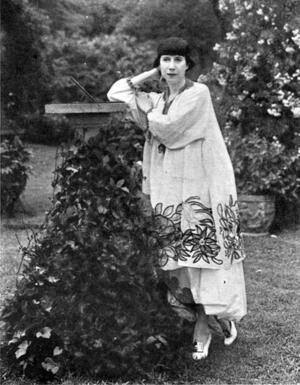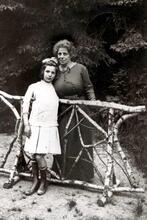Florine Stettheimer
Florine Stettheimer (1871–1944), American artist, in her Bryant Park garden.
Image courtesy of Columbia University via Wikimedia Commons.
Florine Stettheimer's paintings are lively, diarylike accounts of her life and acute examinations of upper-class ways in New York between the wars. Her decorative, figurative style, often characterized as feminine, offered an alternative to prevailing modes of contemporary modernist painting. With her sisters, she ran New York salons that welcomed Marcel Duchamp and Georgia O’Keeffe. In 1934 she designed sets and costumes for Four Saints in Three Acts, an avant-garde opera by Gertrude Stein and Virgil Thompson. After Florine’s death, her sister Ettie published an anthology of her poems, Crystal Flowers, in 1949; it was reissued in 2010. She also sold many of Stettheimer’s paintings to museums: her final series of four paintings, Cathedrals, depicting street scenes throughout Manhattan, now hangs in the Metropolitan Museum of Art.
The career of Florine Stettheimer, painter, poet, and designer, disproves the myth of the artist as a lonely and misunderstood genius, struggling to produce works that transcend his (and less frequently, her) own historical time and place. Stettheimer’s paintings are lively, diarylike accounts of her life, but also acute examinations of upper-class ways in New York between the wars. Her decorative, figurative style, often characterized as feminine, offers an alternative to prevailing modes of contemporary modernist painting.
Early Life and Family
Born on August 29, 1871, in Rochester, New York, to Rosetta (Walter) and Joseph Stettheimer, Florine Stettheimer was the fourth of five children. The members of her extended family were wealthy and influential assimilated Jews who were comfortable moving between Europe and America. By 1883, the Stettheimers were living in Germany, where Florine received her elementary schooling. It was during this time that their father abandoned the family for reasons that are unclear. Rosetta Stettheimer never remarried, and the three youngest daughters, Carrie, Florine, and Ettie, remained single and lived with their mother until her death in 1935, forming a distinctly matriarchal household. Florine began her formal art training in 1892 at New York’s Art Students League, where she studied with the idealist Kenyon Cox and the realist Robert Henri. Her early work reflects academic training tempered by a bright palette and pronounced brushstroke that attest to her exposure to postimpressionism during her family’s extensive travels in Europe. But shortly after World War I forced the Stettheimers’ return to New York in 1914, Florine began to paint in a stylized and richly colored manner that owed as much to popular illustration as it did to fine art.
Painting Career
Stettheimer’s paintings from 1917 form an unprecedented pictorial category that is part portraiture, part history painting, and part genre painting. Many works, such as La Fête à Duchamp (1917) and Asbury Park South (1920), commemorate outings and parties organized by her family and can be read as biographical. But these real events and their protagonists are described in a style so fantastic in its miniaturization and decorative excess that they take on a theatrical aspect that betrays the critical distance of their author. For, in spite of the lively art salon cultivated by the three sisters, Florine Stettheimer maintained the stance of the detached observer, recording events for the private pleasure of friends and family. Except for an early solo exhibition at the Knoedler Gallery, she seldom showed her work, and never sold it. And although she painted many portraits, whimsical works that describe their subjects less by resemblance than by attributes, they were always of friends: artists and writers such as Marcel Duchamp, Alfred Stieglitz, and Carl Van Vechten.
Stettheimer was a member of the American Society of Painters, Sculptors, and Engravers, and entered work annually in the exhibitions of the Society of Independent Artists. In 1934, she made her most public appearance when she designed the sets and costumes for the premiere production of Four Saints in Three Acts, the avant-garde opera by Gertrude Stein and Virgil Thomson. Her best-known works, however, are four paintings celebrating modern life in New York: Cathedrals of Broadway (1929), Cathedrals of Fifth Avenue (1931), Cathedrals of Wall Street (1939), and Cathedrals of Art (1942), all now housed in New York’s Metropolitan Museum of Art. These paintings are historical documents at once public and private and are presented with wit and irony in a style whose ornamental superfluity celebrates the popular culture of her own time.
Legacy
Florine Stettheimer died in New York on May 11, 1944, while still at work on the last of the Cathedrals paintings. She was seventy-three years old. Following her death, her sister Ettie published a volume of Florine’s poetry, entitled Crystal Flowers (1949). Her reputation, though eclipsed by the rise of abstract expressionism in the 1950s, has continued to grow, particularly since her paintings share in many concerns that occupy postmodernist art. In her poems and in her paintings, Stettheimer described a world in which people define themselves by the things that surround them, rather than by their internal values or beliefs. Through the form and content of her work, she criticized the high-mindedness of modern art and the course of modern life.
Bloemink, Barbara. The Life and Art of Florine Stettheimer. New Haven: Yale University Press, 1995.
Brown, Stephen and Uhlyarik, Georgiana. Florine Stettheimer: Painting Poetry. Exh. cat. New Haven: Yale University Press, 2017.
Nochlin, Linda. “Florine Stettheimer: Rococo Subversive.” Art in America 68 (September 1980): 64–83.
Stettheimer, Florine. Crystal Flowers (1949), and Exhibition File. Museum of Modern Art Archives, NYC, and Papers. Columbia University, Rare Book and Manuscript Library, NYC.
Stettheimer, Florine, and Ettie Stettheimer. Papers. Collection of American Literature, Beinecke Rare Book and Manuscript Library, Yale University, New Haven, Conn.
Sussman, Elisabeth, and Barbara J. Bloemink. Florine Stettheimer: Manhattan Fantastica. Exhibition catalog (1995).
Tyler, Parker. Florine Stettheimer: A Life in Art. New York: Straus and Co., 1963.
Whiting, Cécile. “Decorating with Stettheimer and the Boys.” American Art 14, no. 1 (Spring 2000): 24-49.




